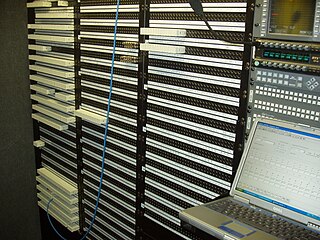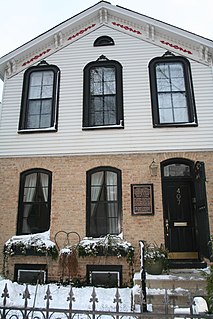In telecommunication, a private line is typically a telephone company service that uses a dedicated, usually unswitched point-to-point circuit, but it may involve private switching arrangements, or predefined transmission physical or virtual paths. Most private lines connect only two locations, but some have multiple drop points. If the circuit is used for interconnecting switching systems, including manual switchboards, it is often called a tie line.
Telephony is the field of technology involving the development, application, and deployment of telecommunication services for the purpose of electronic transmission of voice, fax, or data, between distant parties. The history of telephony is intimately linked to the invention and development of the telephone.
In electronics, a crossbar switch is a collection of switches arranged in a matrix configuration. A crossbar switch has multiple input and output lines that form a crossed pattern of interconnecting lines between which a connection may be established by closing a switch located at each intersection, the elements of the matrix. Originally, a crossbar switch consisted literally of crossing metal bars that provided the input and output paths. Later implementations achieved the same switching topology in solid state semiconductor chips. The cross-point switch is one of the principal switch architectures, together with a rotary switch, memory switch, and a crossover switch.

A blue box is an electronic device that generates the in-band signaling audio tones formerly used to control long-distance telephone exchanges. By generating the same tones employed by a telephone operator's dialing console, a blue box user could route their own calls and bypass the normal toll collection by the telephone company. Developed in the 1960s, the most typical use of a blue box was to place free long-distance telephone calls. A related device, the black box, enabled one to receive calls which were free to the caller. The blue box no longer works in most Western nations, since to prevent this form of fraud, modern switching systems no longer use in-band signaling. Instead, signaling occurs on an out-of-band channel that cannot be accessed from the line the caller is using, a system called Common Channel Interoffice Signaling or CCIS.
In telecommunications, trunking is a method for a system to provide network access to many clients by sharing a set of lines or frequencies instead of providing them individually. This is analogous to the structure of a tree with one trunk and many branches. Examples of this include telephone systems and the two-way radios commonly used by police agencies. Trunking, in the form of link aggregation and VLAN tagging, has been applied in computer networking as well.

In the early days of telephony, through roughly the 1960s, companies used manual telephone switchboards, and switchboard operators connected calls by inserting a pair of phone plugs into the appropriate jacks.
A softswitch is a central device in a telecommunications network which connects telephone calls from one phone line to another, across a telecommunication network or the public Internet, entirely by means of software running on a general-purpose computer system. Most landline calls are routed by purpose-built electronic hardware; however, soft switches using general purpose servers and VoIP technology are becoming more popular.

A business telephone system is a multiline telephone system typically used in business environments, encompassing systems ranging from the small key telephone system (KTS) to the large private branch exchange (PBX).
The Traffic Service Position System (TSPS) was developed by Bell Labs in Columbus, Ohio to replace traditional cord switchboards. The first TSPS was deployed in 1969 and used the Stored Program Control-1A CPU, "Piggyback" twistor memory and Insulated Gate Field Effect Transistor solid state memory devices similar to dynamic random access memory.

Hook flash or flash is a button on a telephone that simulates quickly hanging up then picking up again. This action can signal the telephone exchange to do something. A common use of a hook flash is to switch to another incoming call with the call waiting service. Another use is to indicate a request for voice conferencing, for example, a user may use a procedure like the following to initiate three-way calling:
- Pick up phone handset.
- Hear a dial tone
- Dial the first number and greet the first party
- Press the hook flash button
- Hear a stutter dial tone
- Dial the second number and greet the second party
- Press the hook flash button again.

An attendant console is a telephone station that is generally part of a private branch exchange (PBX) or Centrex or other private telephone system. An attendant console generally is a regular PBX telephone station with one or more additional modules each bearing numerous buttons that can be programmed to be associated with particular lines in the private telephone system, or with particular specialized functions.

A patch panel, patch bay, patch field or jack field is a device or unit featuring a number of jacks, usually of the same or similar type, for the use of connecting and routing circuits for monitoring, interconnecting, and testing circuits in a convenient, flexible manner. Patch panels are commonly used in computer networking, recording studios, radio and television.
In residential telephony, an extension telephone is an additional telephone wired to the same telephone line as another. In middle 20th century telephone jargon, the first telephone on a line was a "Main Station" and subsequent ones "Extensions". Such extension phones allow making or receiving calls in different rooms, for example in a home, but any incoming call would ring all extensions and any one extension being in use would cause the line to be busy for all users. Some telephones intended for use as extensions have built in intercom features; a key telephone system for a small business may offer two to five lines, lamps indicating lines already in use, the ability to place calls on 'hold' and an intercom on each of the multiple extensions.
The Number Five Crossbar Switching System is a telephone switch for telephone exchanges designed by Bell Labs and manufactured by Western Electric starting in 1947. It was used in the Bell System principally as a Class 5 telephone switch in the public switched telephone network (PSTN) until the early 1990s, when it was replaced with electronic switching systems. Variants were used as combined Class 4 and Class 5 systems in rural areas, and as a TWX switch.
The Number One Crossbar Switching System, was the primary technology for designing urban telephone exchanges in the Bell System in the mid-20th century. Its switch fabric used the new electromechanical crossbar switch to implement the topology of the panel switching system of the 1920s. The first 1XB system was installed in the PResident-2 office at Troy Avenue in Brooklyn, New York which became operational in February 1938.
A junctor is a circuit used in analog telephone exchanges, including the Number One Crossbar Switching System, Number Five Crossbar Switching System, Panel switch, 1ESS switch and other switches.

Joseph John O'Connell, 1st, was an electrical engineer and inventor. He worked for the Chicago Telephone Company in the late 19th and early 20th centuries. He had many inventions including the circuit breaker and the coin return. He also created the "invisible wire" which was the first time more than one telephone conversation could occur on the same wire. Reference to some additional inventions are mentioned in Angus Hibbard's autobiography, Hello- Goodbye including an electric lamp as a signal in a burglar-alarm operated by the telephone company in 1886.

The Panel Machine Switching System is an early type of automatic telephone exchange for urban service, introduced in the Bell System in the 1920s. It was developed by Western Electric Laboratories, the forerunner of Bell Labs, in the U.S., in parallel with the Rotary system at International Western Electric in Belgium before World War I. Both systems had many features in common.













